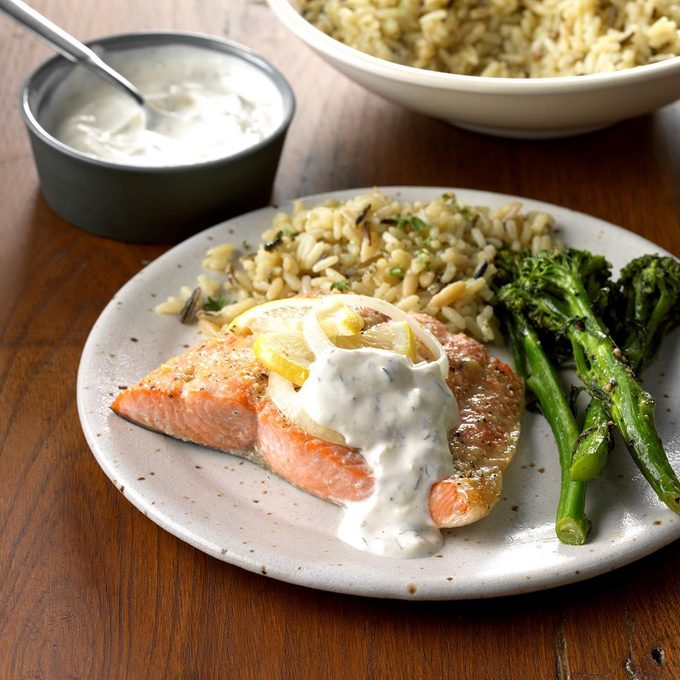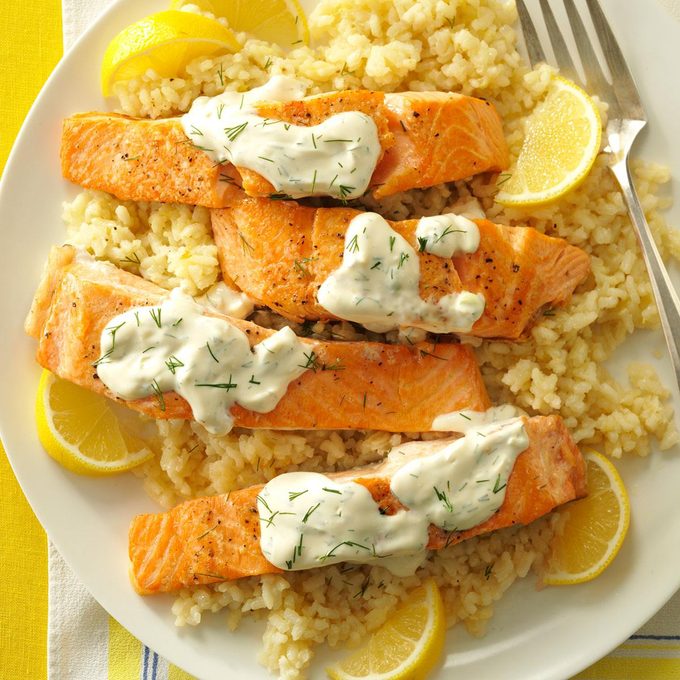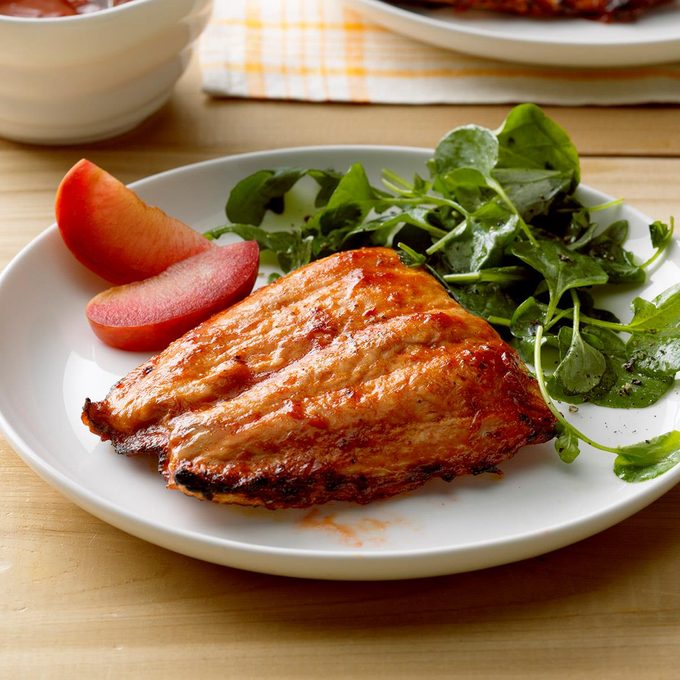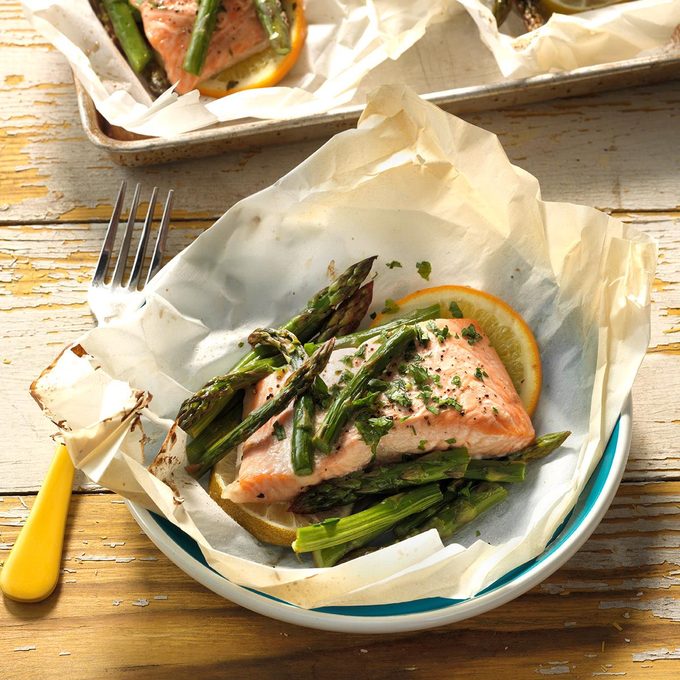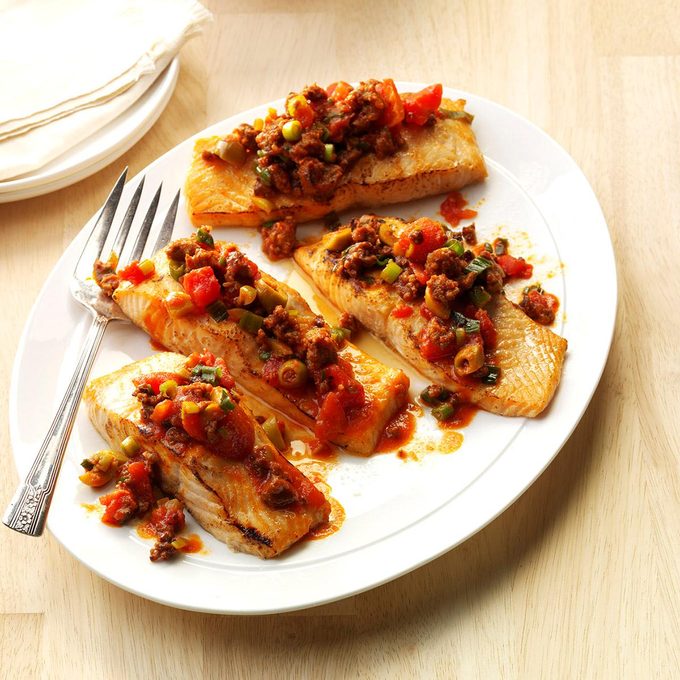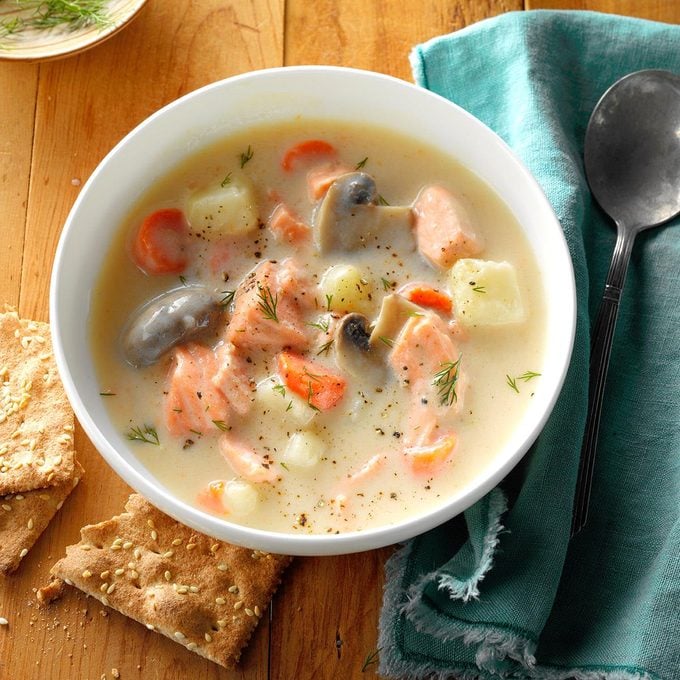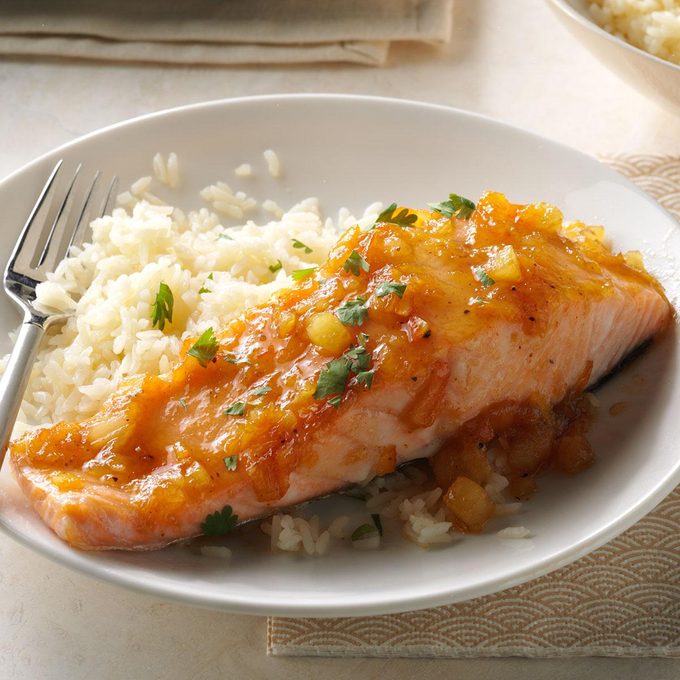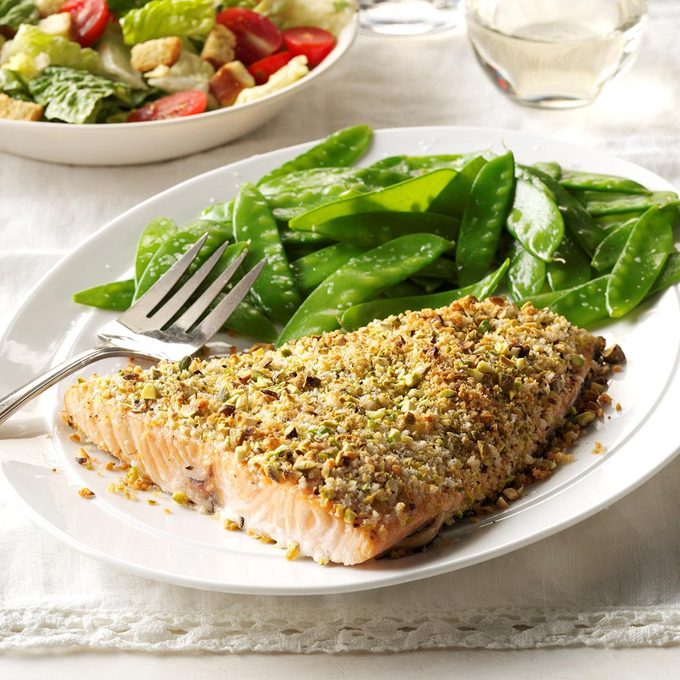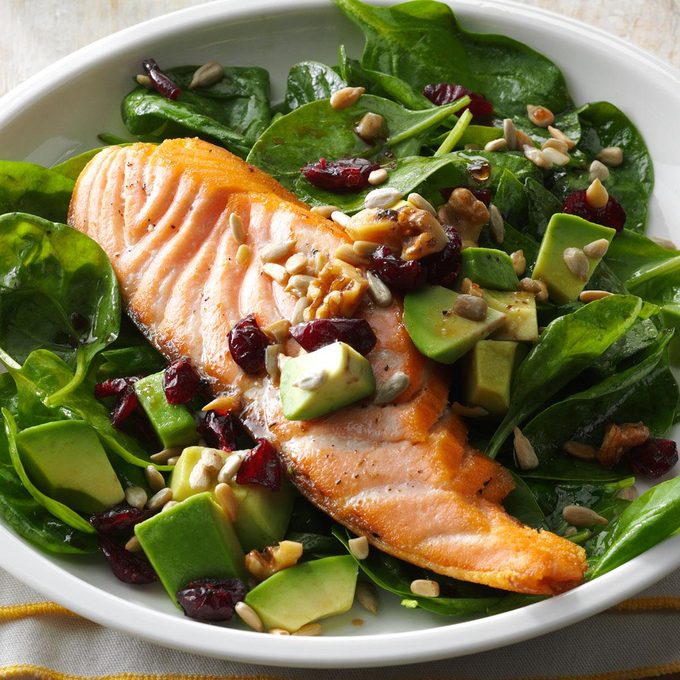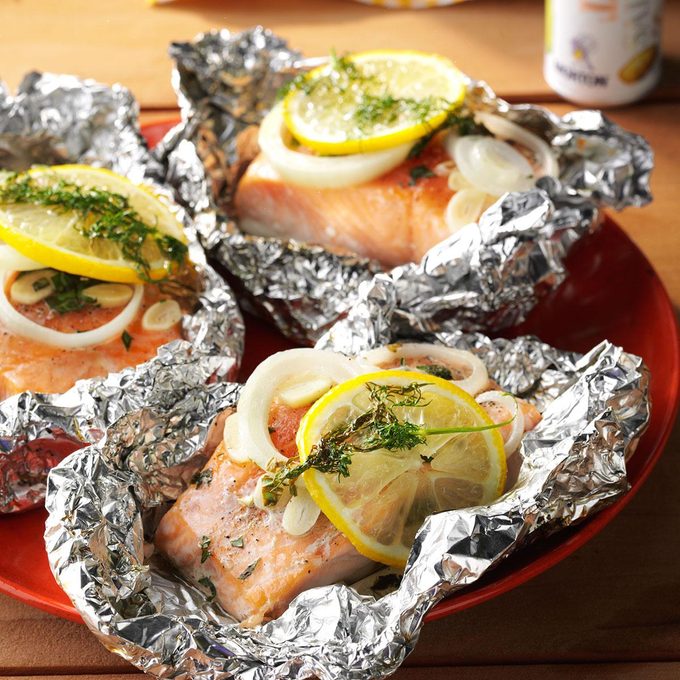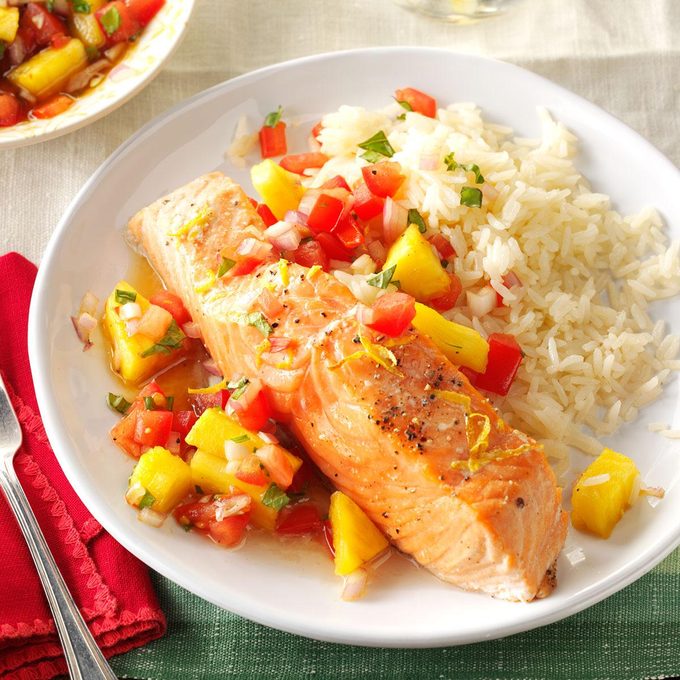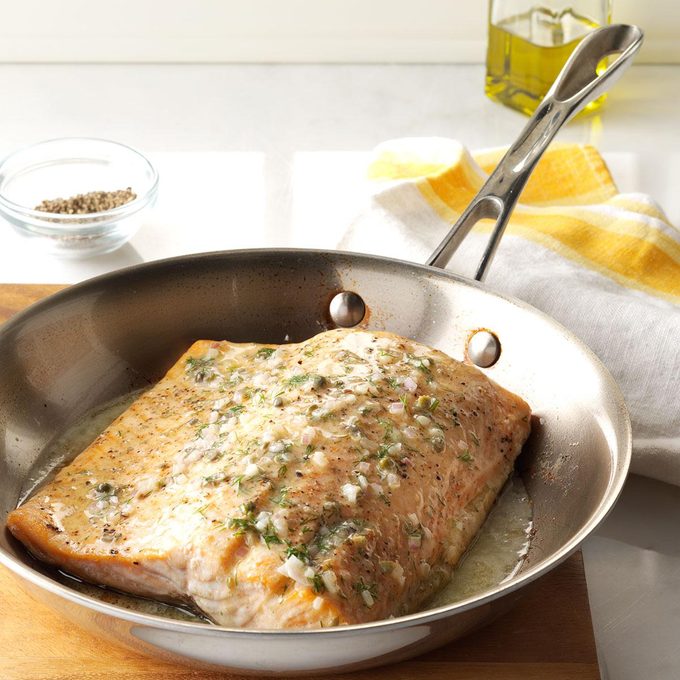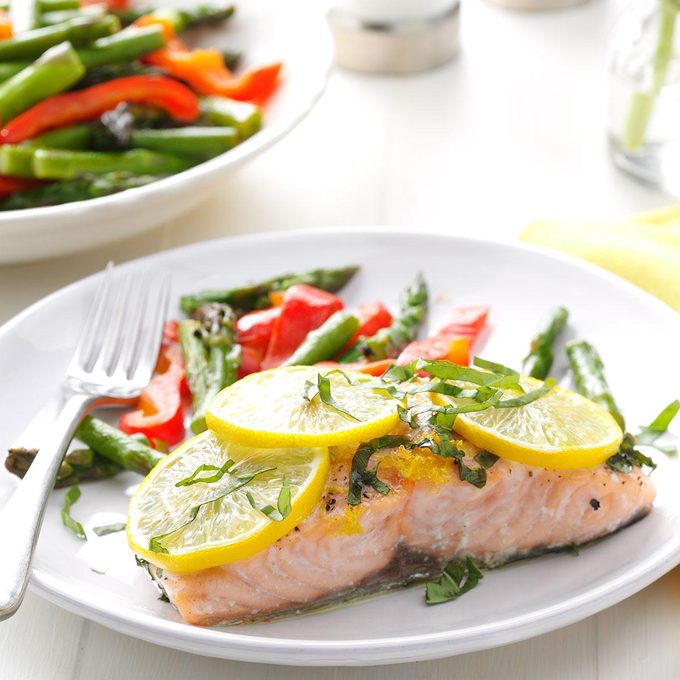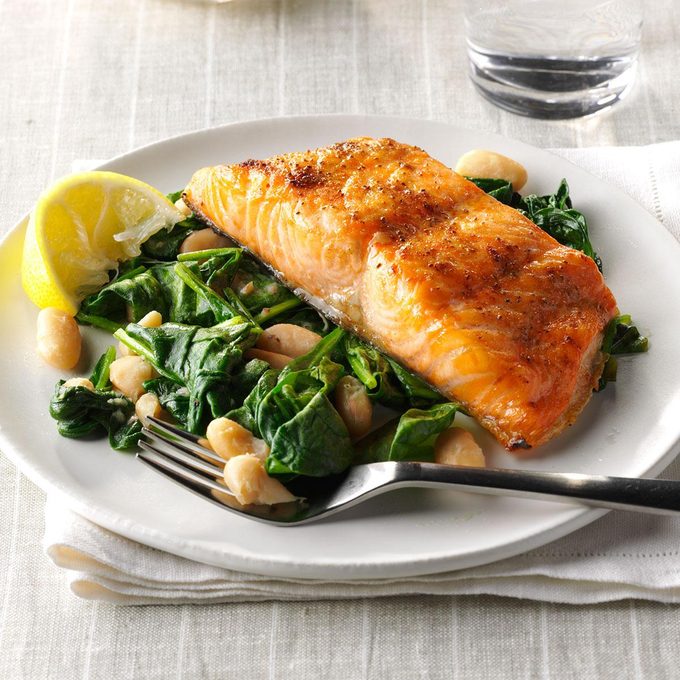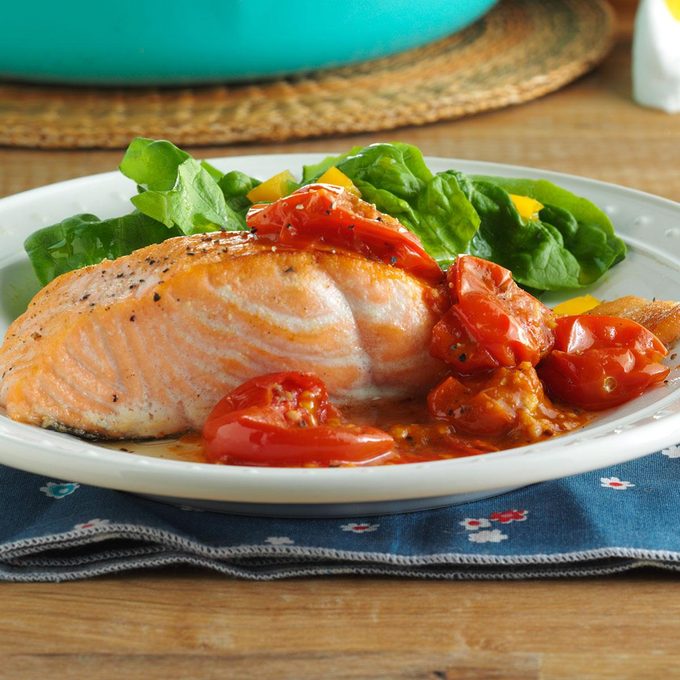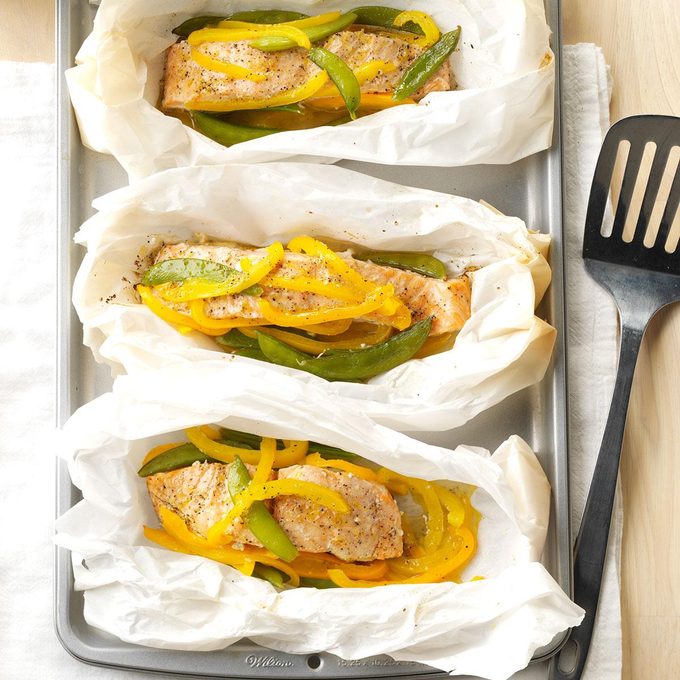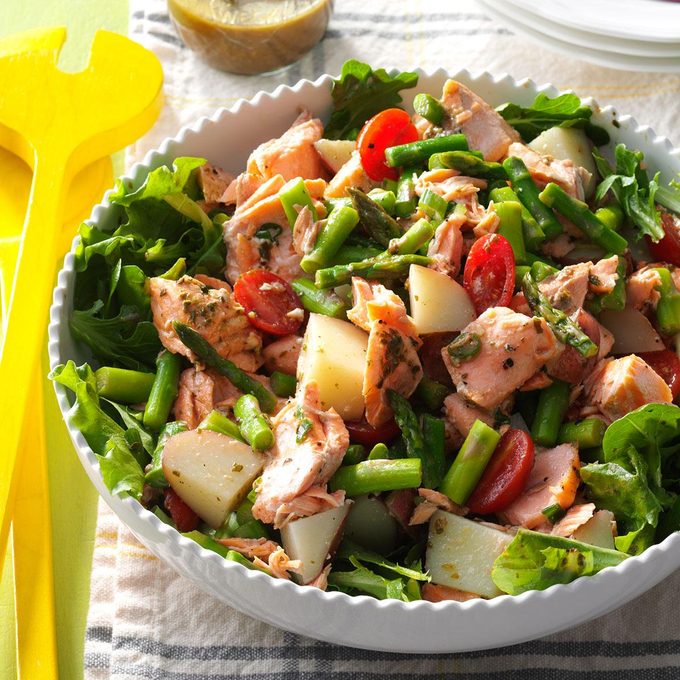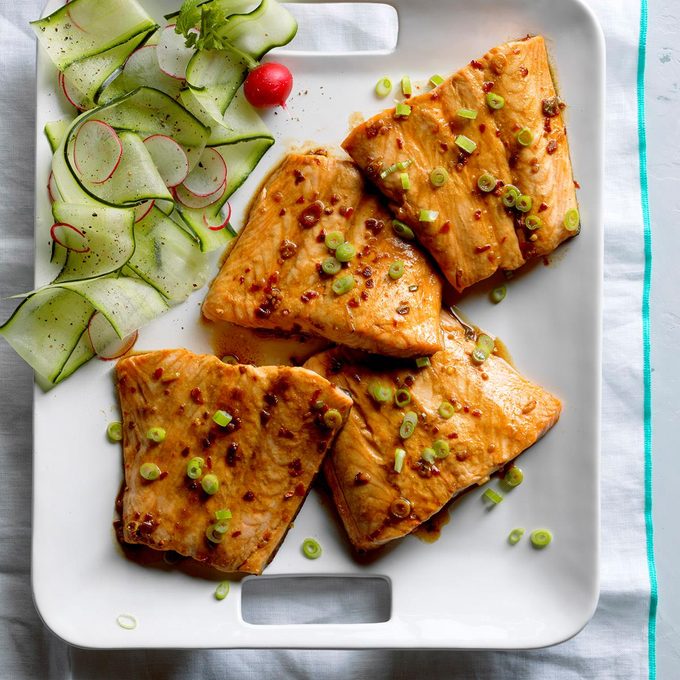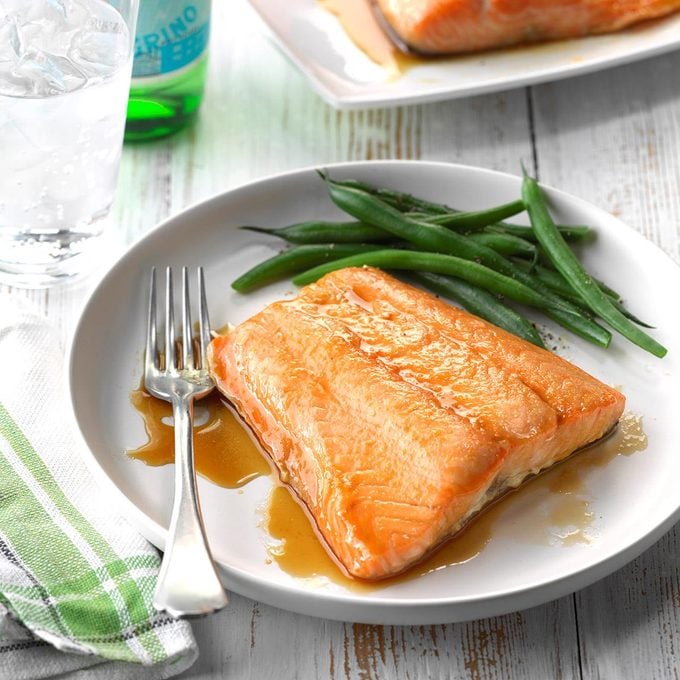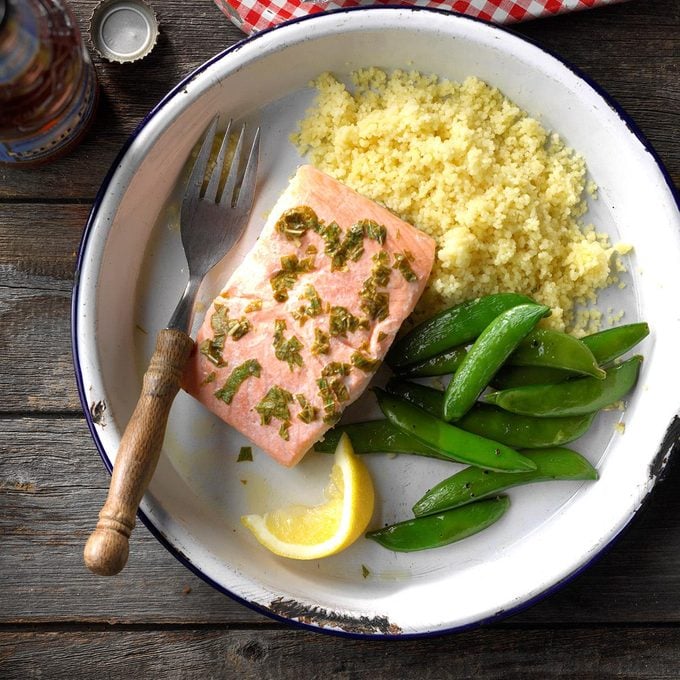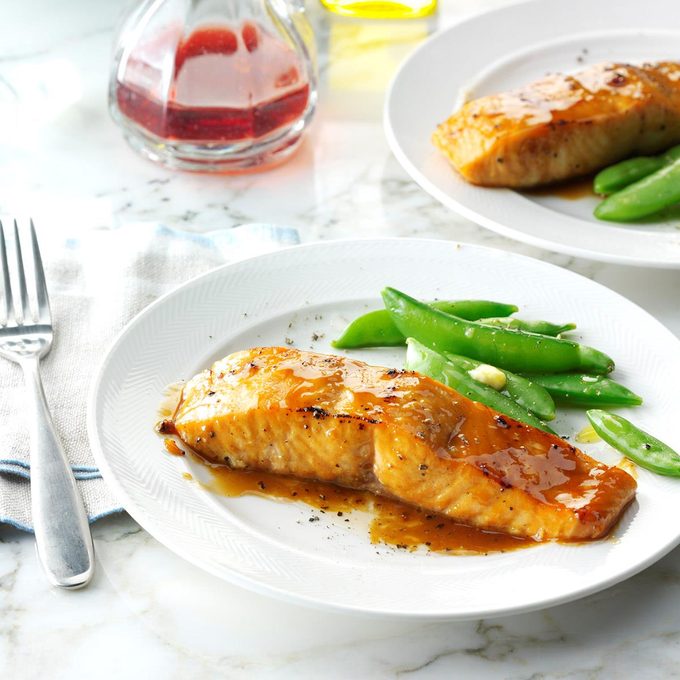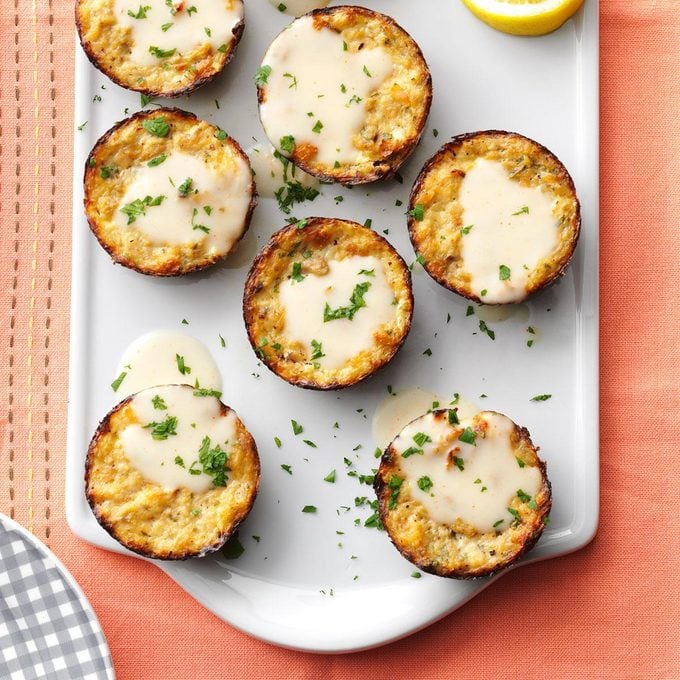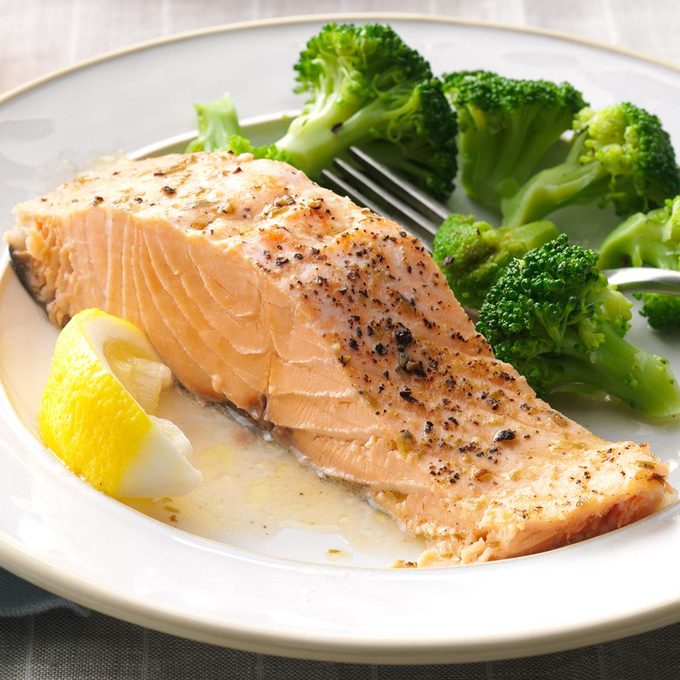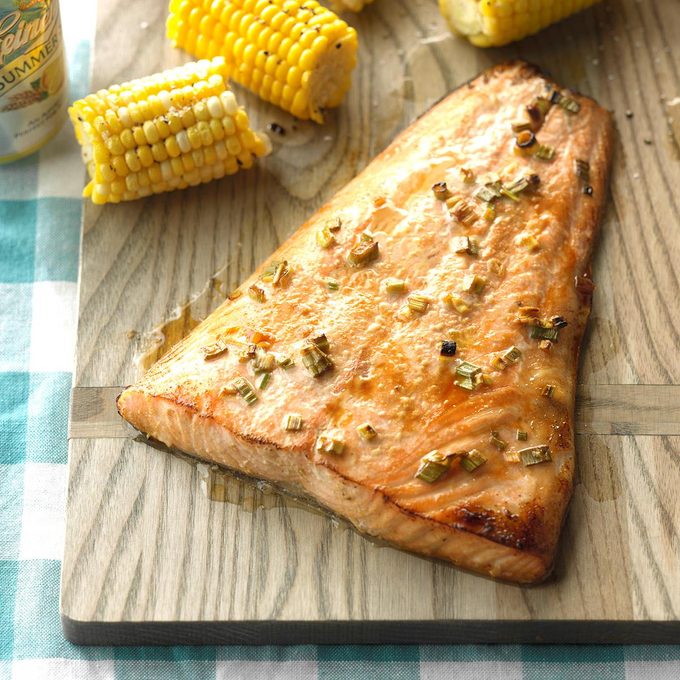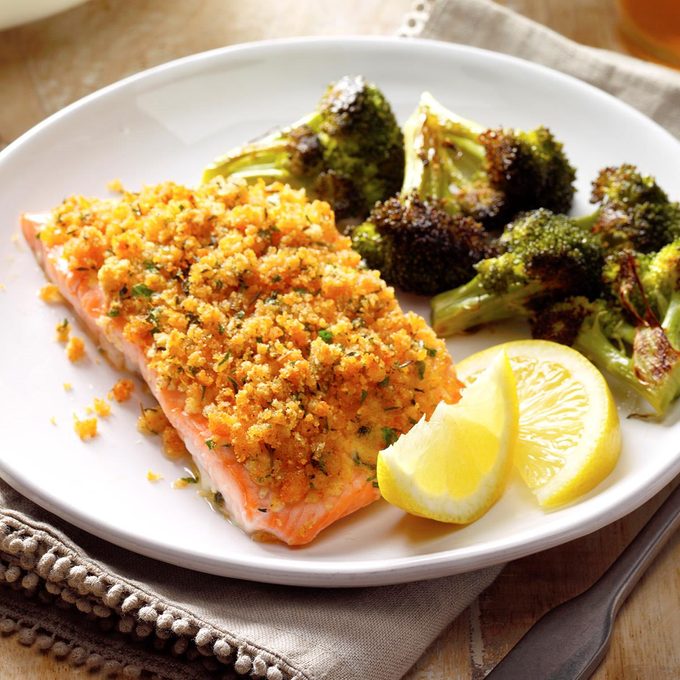Not sure how to buy salmon? That’s totally understandable. It’s not as simple as buying strawberries, where you only have to choose from organic or conventional, fresh or frozen. There are different species of salmon, with different sizes, colors and flavor profiles. Salmon are also raised in different ways that can be better or worse for your health, the environment and the sustainability of the species.
To help you make the best choice,, we’ve put together a thorough guide to how to buy salmon.
Different Cuts of Salmon
The first key to buying a delicious piece of salmon is knowing which cut to buy. The cooking method you want to use and the recipe you’re preparing should guide your choice. Here are your options:
Salmon steaks
This thick, crosswise cut of a larger fish includes both sides of the salmon and has a round bone (the salmon’s backbone) in the middle. It holds up well to grilling, but can also be pan-fried or baked, like in this Lemon-Garlic Salmon recipe.
Side of salmon
The side is the part between the head and the tail. Basically, it’s a fillet that weighs several pounds. When you buy a side of salmon, it may contain scales, belly bones and pin bones, all of which you should remove before eating. Better yet, ask the person working at the seafood counter to remove them at the store.
Salmon fillets
A fillet is what you’re most likely to buy at the store or be served in a restaurant. It’s a smaller portion of a side of salmon. The side has five parts: top loin, loin, belly, second cut and tail. Each has a different shape and fat content that makes it ideally suited for certain preparations, from sashimi to pan searing.
Whole salmon
A whole salmon is just what it sounds like: both sides of the fish, including the head, tail, scales and bones. You can bake a whole salmon, or break it down and cook each part in a specific way.
What to Look for in Salmon
Now that you know what the different cuts of salmon are, it’s time to learn how to choose high-quality fish. Here’s what to look for:
Color
Salmon will be light pink to red, depending on the species. The color should be vibrant, with no darkening around the edges.
Smell
Salmon should smell like the ocean—like a nice day at the beach. It should not smell fishy or off-putting.
Texture
Salmon flesh should be firm and, if not frozen or previously frozen, shiny. A whole fish should have bright, clear, protruding eyes.
Packaging
If you’re purchasing still-frozen salmon, make sure the package has no ice crystals, frost, discoloration or liquid. If you’re purchasing previously frozen “fresh” salmon from the refrigerator case, make sure it is tightly sealed, wrapped or vacuum packed.
Sourcing of Salmon
When you’re shopping for salmon, the labeling should tell you where it was raised or caught, where it was processed and whether it was farm-raised or wild-caught. For example, you might see something like “wild-caught Alaskan salmon, product of China.” It’s common practice to send fish overseas for processing because the labor is cheaper.
Should I Buy Farmed or Wild Salmon?
If you’re wondering whether to by farmed or wild salmon, you probably have two concerns: sustainability and nutrition. Both farmed and wild salmon can be produced sustainably or unsustainably in ways that are good, bad or neutral for both fish populations and the broader environment. And both have nutritional benefits and drawbacks.
Environmentally Sustainable Salmon
Farmed salmon can be raised sustainably in indoor recirculating tanks with wastewater treatment, or unsustainably in indoor recirculating tanks without wastewater treatment. Salmon can also be farmed in the ocean, but open-ocean salmon farms can threaten wild salmon populations and cause larger environmental problems.
Wild salmon can be caught in a variety of ways, but knowing the fishing method alone is usually not enough to tell you if a particular salmon is a sustainable choice. For example, some types of troll-caught salmon, which are caught in the ocean one at a time with a hook and line, are sustainable, and others are not. No matter how it is caught, sustainable wild salmon comes from fish populations that are not endangered.
The distinction between farmed and wild also matters when you’re choosing Atlantic vs. Pacific salmon. If you’re buying Atlantic salmon, it should be farmed. Wild Atlantic salmon have been overfished, and at least one species is endangered.
What about Pacific salmon? Many types are protected under the Endangered Species Act because their populations have been diminished by habitat destruction and hydroelectric dams. However, Pacific salmon may be wild or farmed, and wild stocks may be supplemented with young fish from hatcheries to keep populations up.
When you’re at the store, a simple shortcut is to look for salmon that is Marine Stewardship Council Certified. MSC certification tells you the salmon was produced sustainably. Another source to check is the Monterey Bay Aquarium’s Seafood Watch Guide. It gives salmon best, certified, good and avoid ratings to help consumers make sustainable choices.
Nutrition of Wild vs Farmed Salmon
Wild and farmed salmon eat different diets that give them different nutritional profiles. Farmed Atlantic salmon tends to be much higher in fat (and therefore calories). Wild salmon is higher in calcium, iron, potassium and zinc. Both are excellent sources of omega-3 fatty acids. And both have healthy monounsaturated and polyunsaturated fats in addition to less healthy saturated fats.
Wild salmon is never produced with antibiotics and may be lower in an environmental pollutant called PCBs, so if you can afford its higher price and you like the taste, it may be a healthier choice. If you eat salmon in moderation, the potential downsides are not a serious risk, health experts say.
What about organic salmon? That’s not a real thing in the United States, but a Canadian company called Creative Salmon raises certified organic chinook salmon.
How Much Salmon to Buy per Person
Speaking of nutrition, if you’re buying Atlantic salmon, you may want to buy just three to four ounces of uncooked salmon per person and round out the meal with grains and veggies.
For leaner cuts of wild salmon or when you want to indulge, six to eight uncooked ounces is a good serving size. Raw salmon will lose about 25% of its weight after cooking.
Fresh vs Frozen Salmon: Which Is Better?
Most salmon is frozen shortly after it’s caught to preserve its flavor and quality. If you want truly fresh salmon, you’ll need to eat it locally and in season.
Keep in mind that frozen salmon, like other frozen fish, is not an inferior product. The flash-freezing process locks in the freshness we’re all looking for.
Once you bring your salmon home, store it in the fridge at 40°F or lower for no longer than two days before cooking it. If it’s already frozen, store it at 0°F or lower and use within eight months.
Store cooked salmon in the fridge for up to four days. Unopened canned salmon will keep in a cool, dry place for up to five years.
Types of Salmon
Atlantic Salmon
Also known as sea run salmon, kelts or black salmon, there are three types of wild Atlantic salmon: North American, European and Baltic. Wild North American salmon are not commercially fished because of their endangered status. If you’re buying Atlantic salmon in the United States, expect it to be farmed. This fish has a mild flavor and light pink color. Try it in one of our easy salmon recipes.
Pacific Salmon
Pacific salmon live off the west coast of Canada and the northern United States. King, coho, sockeye, pink and chum are all Pacific salmon. You can find both wild and farmed Pacific salmon at the store.
King Salmon
Also called chinook salmon, king salmon is the largest of the Pacific salmon. It’s also the highest in fat, with a silky texture that’s good for poaching or smoking.
Sockeye Salmon
Also called red salmon, sockeye salmon is stronger in favor and lower in fat than other varieties. You’ll find it served raw, smoked, canned and in burgers.
Coho Salmon
Also called silver salmon, coho salmon has a mild taste, delicate texture and medium fat content. Because they’re smaller, they’re good for poaching or roasting whole. Northwestern coho salmon are threatened under the Endangered Species Act due to commercial overfishing and habitat loss, but several types of wild-caught coho are sustainable. Try it in one of our top salmon recipes.
Pink Salmon
Pink salmon are usually canned. They’re lower in fat and best used in salads and salmon cakes. Try it in our Speedy Salmon Patties for a light meal.
Chum Salmon
Chum or keta salmon are a popular source of salmon roe (caviar). They’re lower in fat and good for drying, smoking, grilling or roasting.
Salmon Recipes to Make for Dinner
I headed straight for the kitchen when I decided to pick up a healthier lifestyle. This salmon with veggies proves that smart choices can be simple and satisfying. —Matthew Teixeira, Milton, Ontario
You'll want to "reel in" our healthy salmon recipes, too.
Impress everyone at your table with this elegant but easy salmon that's delicious and nutritious. You can substitute scallions for shallots if you like. —Linda Press Wolfe, Cross River, New York
If you’re new to cooking fish (or even if you’re a pro), this no-fail salmon recipe is a must-make. It’s easy enough for everyday, but also wows at dinner parties. —Margee Berry, White Salmon, Washington
There's nothing like fresh salmon, and my mom bakes it just right so it nearly melts in your mouth. The sour cream dill sauce is subtly seasoned with horseradish so that it doesn't overpower the delicate salmon flavor. —Susan Emery, Everett, Washington (Here are more
baked salmon recipes to try!)
I created this recipe as a healthier alternative to whitefish chowder, which is a favorite in the area where I grew up. The salmon and sweet potatoes boost the nutrition and the slow cooker makes it more convenient. It's especially comforting on a cold fall or winter day! —Matthew Hass, Franklin, Wisconsin
Our family loves salmon prepared this way, and it's a real treat to make on a warm summer evening. These fillets may be baked in the oven at 450 degrees for 18 minutes, basting occasionally. —Wanda Toews, Cromer, Manitoba
I developed this flavor-packed dinner for a busy friend who wants to eat clean. —Nicole Stevens, Austin, Texas
I love the classic combination of lemon and fish, and this dish is delicious and easy to throw together at the end of a long day. —Amanda Reed, Nashville, Tennessee
I created this sweet and spicy salmon after being challenged to use healthier ingredients. The fresh plum sauce really complements the smoky grilled fish. —Cheryl Hochstettler, Richmond, Texas
Like a lot of people here in the beautiful Pacific Northwest, my boyfriend, Michael, loves to fish. When we have an abundance of fresh salmon on hand, this is one way we cook it. —Amy Paul Maynard, Albany, Oregon
This salmon dish is so simple and easy to make yet so delicious, elegant and impressive. —Dahlia Abrams, Detroit, Michigan
Every one of the ingredients in this recipe brings a ton of flavor. Both chorizo and salmon cook in a hurry, and garlic and citrus go beautifully with them, too. —Charlene Chambers, Ormond Beach, Florida
This is the best soup I have ever made, according to my husband, who loves salmon so much that he could eat it every day. Salmon is a treat for both of us, so when I get some, I try to make it a very special dish like this one. —Hidemi Walsh, Plainfield, Indiana
My mouth waters when I think of this sweet and tangy glaze. It's a tropical treat at any time of year. —Naylet LaRochelle, Miami, Florida
This simple salmon gets its crunch from a coating of crushed pistachios, panko bread crumbs and Parmesan cheese. Add steamed veggies and rice and it's dinnertime! —Anthony Oraczewski, Port St. Lucie, FL
We eat fish on Fridays, so I like to experiment with different types. I pulled salmon, spinach and avocado from the fridge for these wraps. My kids loved them, and I love them, too, because they're delicious and they contain all the food groups right in one hand-held meal. —Jennifer Krey, Clarence, New York
We eat a power salad packed with salmon and spinach at least once a week. It’s a cinch to make, even after a hard day’s work. —Jenny Dawson, Fond du Lac, Wisconsin
Grilling in foil is an easy technique I use with foods that cook quickly, like fish, shrimp, bite-sized meats and fresh veggies. The options are endless—and the cleanup is easy. —A.J. Weinhold, McArthur, California
Take lemony salmon fillets to the next level with a fresh, colorful homemade salsa. Just add a simple side of rice for a complete dinner. —Tiffany Hartpence, Lander, WY
This recipe is my "go to" recipe for quick dinners, family or guests. It's colorful, healthy, easy to prepare and absolutely delicious. The best part is it only calls for five ingredients! —Mary Hawkes, Prescott, Arizona
When I’m starving after work, I want a fast meal with no-fail technique. Roasted salmon is super tender and has a delicate sweetness. It’s also an easy wowza for company. —Jeanne Ambrose, Milwaukee, Wisconsin
For those who aren’t wild about fish, this gingery salmon is a game-changer. Baking on foil makes for extra-easy cleanup. —Becky Walch, Orland, California
At our house we opt for healthy foods, and this lemony salmon with basil is a knockout in the good-for-you category. We have it with asparagus or zucchini. —Shanna Belz, Prineville, Oregon
My mother would make this for us on weeknights in summer—this was the only way we would eat fish. You can make the salsa a day ahead of time. Just keep it in the refrigerator in a covered container until ready to use. —Najmussahar Ahmed, Canton, Michigan
My husband, Oscar, is a Southerner at heart. This salmon with garlicky beans and spinach won him over at first bite. —Mary Ellen Hofstetter, Brentwood, Tennessee
We try to eat salmon a lot because it's so healthy, and I love thinking of new ways to make it different and delicious. This dazzler is easy and is my go-to meal for company. —Joni Hilton, Rocklin, California
It sounds basic, but the tomato sauce is so awesome. If you have it, use white wine instead of chicken broth. I like to serve my salmon with asparagus—roast it alongside the fish. —Swati Sharan, Horseheads, New York
Lime with ginger is a favorite flavor combo for me, especially with grilled salmon. So good. Even with the cucumber sauce, this recipe is easy, too. —Noelle Myers, Grand Forks, North Dakota
I feel the spirit of Julia Child when I make lemon-pepper salmon en papillote (in parchment). It’s the first French recipe I learned, and the delightful little packages are family-friendly. —Renee Greene, New York, NY
A bounty of vegetables keeps this salad light on calories, while salmon makes it hearty enough for a meal. It's become a springtime staple at our house. —Frances Pietsch, Flower Mound, Texas
Let this sensational salmon perk up dinner tonight. With a super flavorful glaze that kicks you right in the taste buds, this weeknight dish is anything but boring. —Melissa Rogers, Tuscaloosa, AL
Extra Pesto Grilled Salmon gives this creamy pasta toss a luxurious taste and texture. We love it as is, but you could easily sub in any veggies you have on hand for the broccoli. —Jacob Kitzman, Seattle, Washington
It only takes four ingredients and a few moments of time to make this delightful main dish. —Tara Ernspiker, Falling Waters, West Virginia
Mesquite wood chips give this fish dish a smoky flavor. If using a charcoal grill, add wood chips directly to the coals. If using a gas grill, wrap the chips in a foil pouch; poke several holes in the pouch and place it on the rock grate. —Jeri Kilpatrick, Hoodsport, Washington
It was my husband, Steve, who came up with this easy, foil-packet recipe for flaky, fork-tender Lemon Basil Salmon. We eat a lot of salmon and Steve likes trying out different herbs and spices on our food. This recipe's a winner! —Marianne Bauman, Modesto, California
My family liked this recipe so much one evening that I made it for a potluck the very next day. Everyone raved about it there, too—even people who aren't particularly fond of fish. —Kerin Benjamin, Citrus Heights, California
This main course was invented out of a need to serve my family a balanced meal when time was limited. Even my young son loves it! —Ann Bagdonas of Antioch, California
Pop these protein-packed salmon fillets in the oven before whipping up a sweet basting sauce. This tangy entree cooks up in minutes making it a perfect meal for busy families and unexpected weekend guests. —Debra Martin, Belleville, Michigan
A friend gave me this quick and easy approach to salmon. It has a mildly sweet sauce and is such a hit that I've passed it to other fish fans. —Trish Horton, Colorado Springs, Colorado.
The garlic-seasoned main dish calls for handy pantry ingredients, including pasta and canned salmon. I serve it with asparagus, rolls and fruit. —Theresa Hagan, Glendale, Arizona
This delicious, moist fish is very quick and easy to prepare. It gets a little sweetness from brown sugar, but overall the seasonings are mild and give this dish broad appeal. It's a wonderful way to enjoy healthy salmon.—Donna Reynolds, Innisfail, Alberta
Topped with a zippy white sauce, these little patties bake up golden brown in a muffin pan. They're impressive enough for company but easy enough that I can prepare them any time we like. —Lorice Britt, Severn, North Carolina
I often make this very moist and flavorful oven-baked salmon for company because I can have it ready in less than half an hour. This baked salmon with lemon is well complemented by rice or a green vegetable and a tossed salad. —Emily Chaney, Penobscot, Maine
Ginger, garlic powder and green onion blend nicely in an easy marinade that gives pleasant flavor to salmon. We also like to use this versatile mixture when grilling chicken, but we've found it tastes even better when marinated in the fridge overnight. —Dan Strumberger, Farmington, Minnesota
Often we catch enough of our delicious Northwest salmon to send some to Michigan for my sister to enjoy. This crisp, lemony recipe is a tasty way to enjoy it. —Perlene Hoekema, Lynden, Washington
The post How to Buy Salmon appeared first on Taste of Home.
Amy Fontinelle


